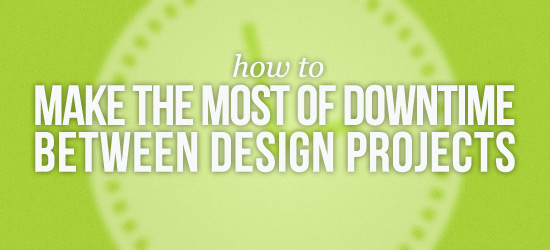If you're looking to hire a development firm to build you a mobile or web app, this Quick Reference Guide is a must-have.
How to Make the Most of Downtime Between Design Projects
BusinessIf you’re a freelancer or a small design studio, chances are you will hit a slow point every once in a while. Whether it’s the time of year, the size of your client pool or some other factor, it happens. The question that arises at this point, then, is what we can do with this downtime to still be productive. How can we make the most of it?

Evaluate Your Business
When times get slow, evaluate your business to see what needs to be updated and/or improved to make sure your business is relevant. Busy work times mean that we can fall behind on maintaining our own business; after all, business is good, so why change anything? This sort of mentality can lead to a slowdown in the future, however.
One method we put in place to make sure Paper Leaf stays relevant is to treat our own projects like client projects. By this, I mean make your business a priority too. It’s easy to continually slot client projects ahead of your own; after all, we see direct financial benefit from doing client work. However, keeping your business up-to-date is imperative for your long-term future.
When I talk about “evaluating your business”, I don’t only mean to look at what needs to be updated. As well, have a look at the numbers: where does most of your income come from? Web design? Development? Identity design? Another example: look at your Analytics and see how people are finding your business, what pages they’re viewing, and so forth. You can learn a lot about your business by crunching a few numbers, and solid decisions can be made when armed with these figures. A quick list of what might be worth looking at during these slow periods:
- how people are finding your business
- how many hits vs. how many follow-throughs (contacts)
- variety of jobs (web vs identity work) vs. percentage of total income
- relevance of current portfolio
Of course, there’s many more items to look at – please let me know some of yours in the comments!
Make Improvements Based on The Evaluation
Evaluating your business is all well and good, but nothing will come of it if you don’t take positive action. A slow period is a perfect time to do this. Once you’ve looked at some data and truthfully evaluated your business, come up with some solutions to found problems and take some action. Using the above list, a basic example would be to update your portfolio if you find your current one is out-of-date. A more in-depth example would be to use your percentage of total income based on jobs (web vs. identity, for example) and tailor your portfolio towards what those jobs that pay better. Alternatively, tailor your portfolio towards what you want to work on.
Further examples: if you evaluate your Analytics and find you’re getting a lot of hits on your home page, but very little follow through (sometimes indicated by a high bounce rate), perhaps it’s time to re-design your home page in order to drive more traffic to the Contact page. These are just a few basic examples of how to take your slow period and turn it into tangible improvements for your business.
Launch an Online Ad Campaign
A slow period is usually accompanied by the desire for more work/clients/projects (unless you are rolling in the dough and just want to go for a long vacation… if so, I hate you because that means you are totally able to hire a vacation agency and check the Survival Cooking List of Best Coolers to take with you, which is something I have always wanted to do). During the slowdown, why not give an online ad campaign a shot? Facebook ads and Google ads are two simple, budget-friendly ways to get your business and services in front of more people.
Contact Your Clients
Finally, don’t forget about your current clients. If times are slow, drop them a line – keep building that relationship, even if you haven’t spoken to them in a little while. Don’t just immediately pitch them services; that’s no way to build a relationship. Make sure that the website you built for them is running to their satisfaction; ask how business is, or if they’ve been on any fun vacations lately. Letting your current clients know you’re thinking of them is easy to do and can often lead to more work. If the opportunity presents itself, let them know about any improvements or additional services you’re now offering – just don’t be a sleazy salesman about it.
Generally, Just Stay Useful
The key to making the most of downtime between design projects is to just stay useful. It’s super easy to sit back during a slow period and complain about how there’s no work or how clients don’t appreciate you. The fact of the matter is, you are in control. There is a lot of work out there to be found, and complaining/being lazy/playing Call of Duty isn’t going to help find it. Take steps during slow periods to improve your business, improve your services, and let people know about it.
What are your thoughts? How do you handle the slow times?
